Round vs. Rectangular Dining Table: Which Shape Perfectly Fits Your Home and Lifestyle?
The dining table is far more than just a piece of furniture; it’s often the very heart of your home. It’s where families gather for daily meals, friends share laughter during dinner parties, and countless memories are made. Choosing the right dining table can profoundly impact your home’s aesthetic, functionality, and overall atmosphere. While numerous shapes exist, the most common and often perplexing dilemma homeowners face is deciding between a classic round dining table or a versatile rectangular one.
This seemingly simple choice carries significant implications for how your space feels, how effectively you can entertain, and the daily rhythm of your household. Understanding the unique benefits and potential drawbacks of each shape is crucial for making an informed decision that you’ll love for years to come. In this comprehensive guide, we’ll break down everything you need to know about round and rectangular dining tables, helping you discover which shape aligns perfectly with your space, style, and lifestyle.
Round Dining Tables: A Hub of Intimacy and Coziness
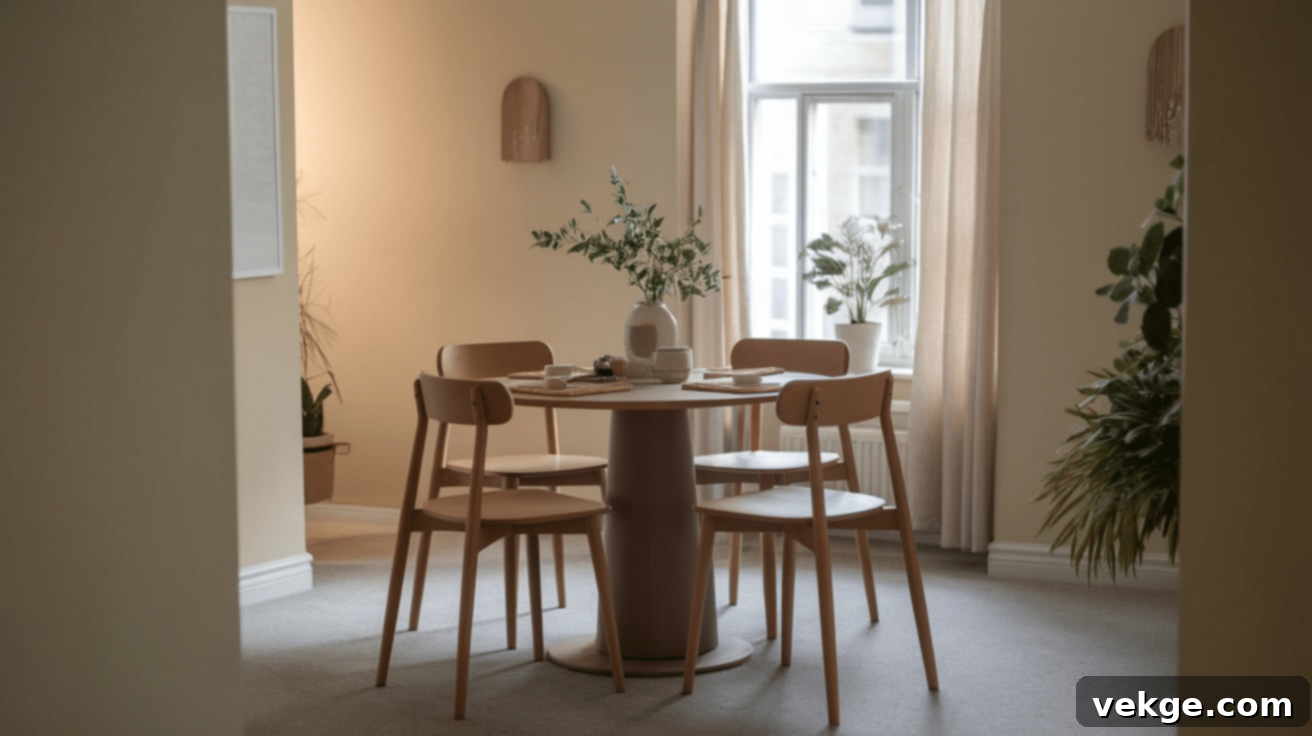
Round dining tables are often celebrated for their soft lines and inviting appeal, naturally creating a sense of togetherness and warmth. They are particularly well-suited for smaller spaces or for individuals who prefer a less formal, more relaxed atmosphere during meals. The circular shape inherently encourages connection, making every seat feel equally important.
Maximizing Space in Compact Areas
If you have a compact dining area, a breakfast nook, or a smaller open-plan living space, a round table is frequently the superior choice. The absence of sharp corners means a round table can fit more easily into tighter spots and allows for smoother movement around it. This not only optimizes the available floor space but also makes the room feel more open, less cluttered, and visually softer. It helps create an illusion of spaciousness, which is invaluable in urban apartments or cozier homes.
Fostering Engaging Conversations
One of the most cherished benefits of a round dining table is its ability to encourage lively and inclusive conversation. With everyone seated in a circle, no one feels like they’re at the “head” or “foot” of the table. This equal positioning ensures that everyone can see and hear each other effortlessly, promoting a more intimate and connected dining experience. It’s perfect for fostering deeper conversations and making every guest feel fully integrated into the gathering.
Enhancing Movement and Flow
The smooth, curved edges of a round table mean there are no sharp corners to bump into, which can be particularly beneficial in high-traffic areas or homes with young children. This ergonomic design allows for easier navigation around the table, improving the overall flow of the room. Moving chairs in and out is also often simpler, contributing to a more comfortable and accident-free dining environment.
Versatile Chair Pairings
A round table offers surprising flexibility when it comes to chair selection. Its adaptable shape often pairs nicely with various chair styles, sizes, and even mismatched sets. This can be a boon for creative homeowners looking to express their unique style or those who need to accommodate different types of seating. The fluid lines of the table tend to harmonize well with diverse chair designs, allowing for a more eclectic and personalized dining setup.
Ideal for Intimate Gatherings and Daily Meals
While some round tables can extend, their inherent design makes them perfect for smaller, more intimate meals. If you don’t frequently host large dinner parties, a round table is excellent for daily family use, couples, or small gatherings of four to six people. It provides just enough space for comfortable dining without overwhelming the room, ensuring a cozy and welcoming atmosphere for everyday moments.
Rectangular Dining Tables: The Epitome of Versatility and Grandeur
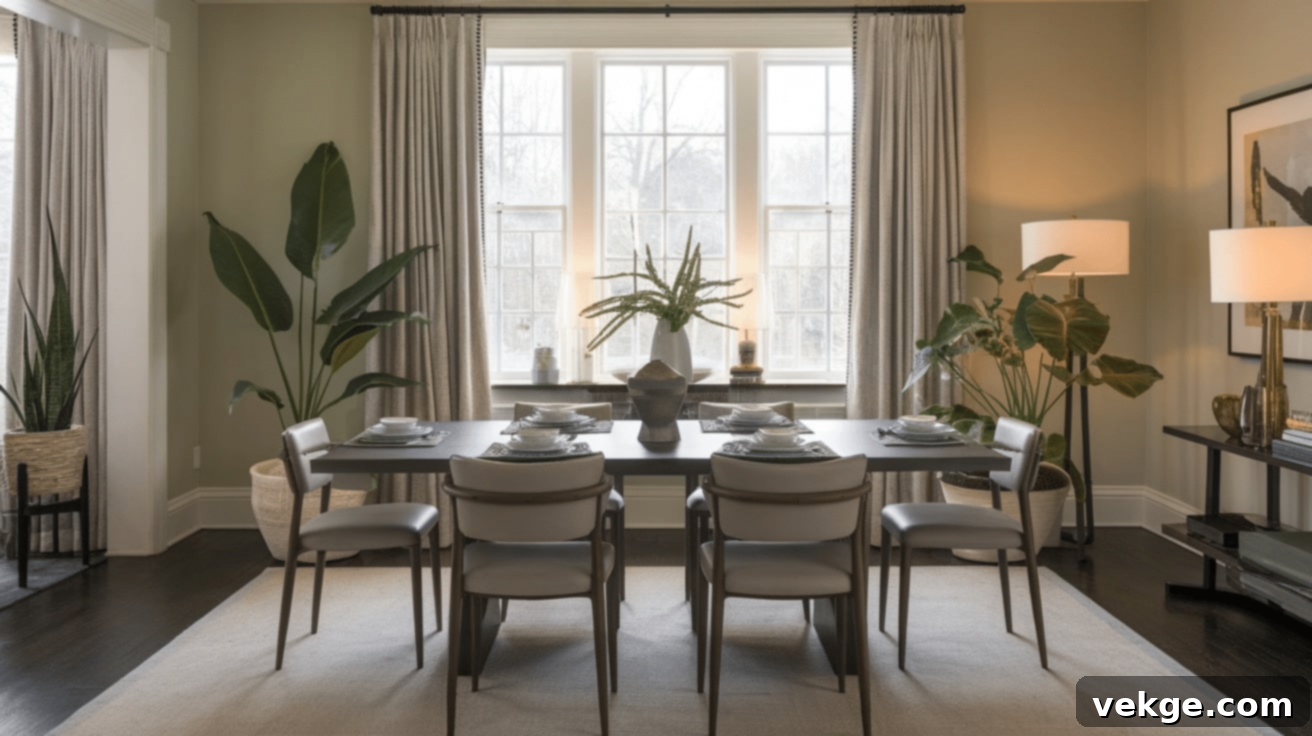
Rectangle dining tables are the most traditional and widely popular choice, known for their versatility and capacity to accommodate larger groups. They provide a more structured and often formal setting, making them a staple in many homes, from grand dining rooms to modern open-plan living spaces.
Perfect for Spacious Dining Rooms and Open Layouts
If you are blessed with a large, dedicated dining room or an expansive open-plan living area, a rectangular table is often the ideal choice. Its linear form naturally fits into long rooms and helps to define a dining zone within a larger open space. A generously sized rectangular table can anchor the room, serving as a prominent focal point and filling out the area without making it feel empty or cavernous. It provides a sense of balance and grandeur.
Superior Seating Capacity and Adaptability
Rectangular tables excel in their ability to seat a greater number of people, making them perfect for large families, frequent entertainers, and holiday gatherings. Their longer edges allow for more chairs to be placed comfortably side-by-side. Many rectangular tables also come with extension leaves, which can be easily added to significantly increase seating capacity when needed, and then removed for everyday use. This adaptability makes them incredibly practical for diverse entertaining needs.
Creating a Formal and Structured Ambiance
For those who appreciate a classic, formal dining experience, a rectangular table is unparalleled. Its traditional shape inherently lends itself to elegant place settings, symmetrical decor, and a sense of order. It’s the go-to choice for hosting sophisticated dinner parties, formal celebrations, or simply for creating a polished and refined dining room aesthetic. Each seat feels designated, contributing to a structured and grand atmosphere.
Effortless Decorating and Styling
Decorating a rectangular dining table is often simpler and more versatile. Its elongated shape provides ample surface area for creative styling. You can easily use long tablecloths, decorative runners, multiple centerpieces, candelabras, or floral arrangements that perfectly suit the linear form. This makes it straightforward to add your personal touch and adapt your decor for different seasons or occasions, creating stunning visual displays.
Multifunctional Work and Dining Hub
Beyond dining, a rectangular table can easily serve as a highly functional, multi-purpose piece of furniture in your home. Its large, flat surface makes it an excellent workspace for remote work, a spacious area for children’s homework, or a generous table for crafts and hobbies. This versatility is particularly valuable in homes where space is at a premium or where the dining area needs to pull double duty, proving its practicality far beyond meal times.
Key Considerations for Your Dining Table Choice
Matching Your Table to Your Space: Room Size and Layout
The size and shape of your dining area are paramount in determining which table shape will function best. A table that is too large can make a room feel cramped, while one that is too small can look lost in an expansive space.
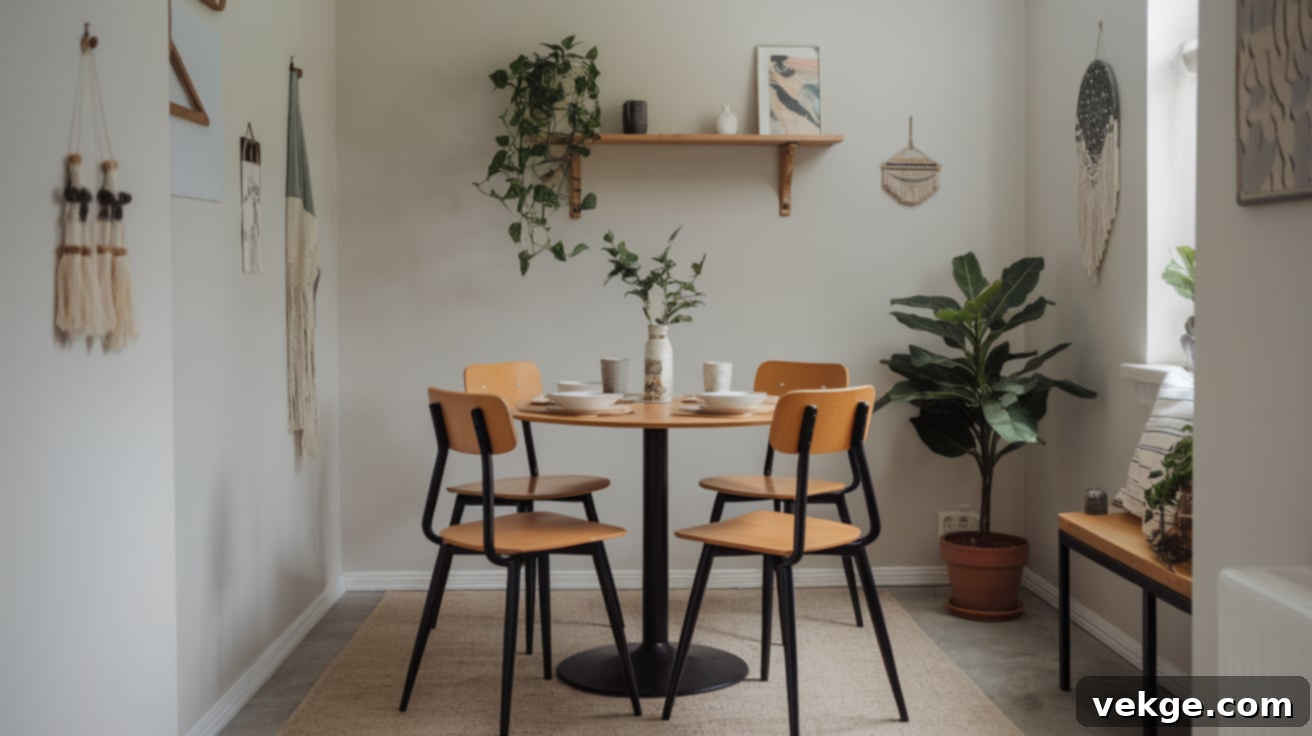
Round Tables: The Small Space Solution
In small dining rooms, kitchen nooks, or areas with awkward angles, a round table is a true space-saving hero. Its lack of sharp corners allows for easier movement around the perimeter, preventing cramped pathways. Visually, the curved lines help to soften the room and make it feel more expansive and inviting. A general rule of thumb is to allow at least 36-42 inches of clearance between the table edge and any wall or furniture for comfortable movement.

Rectangular Tables: Anchoring Larger Areas
For large, rectangular dining rooms or open-concept living spaces, a rectangular table is often the most natural fit. It provides a strong visual anchor and helps to define the dining zone, especially in long, narrow rooms where a round table might look out of place or awkward. Its linear form complements the architectural lines of most homes, creating a balanced and harmonious aesthetic. When choosing a rectangular table for a larger room, ensure it’s proportional to the space to prevent the room from feeling empty or the table from being overwhelmed.
Seating Capacity: How Many Guests Will You Host?
Your typical and maximum seating requirements are critical factors. Consider your household size and how often you entertain guests.
Round Tables: Ideal for Intimate Numbers (4-6)
A standard 48-inch round table comfortably seats four people, while a 60-inch round table can accommodate six. While it’s possible to squeeze an extra person or two, round tables are best suited for smaller, more intimate groups. Some round tables do feature extension mechanisms, transforming them into oval shapes to temporarily increase seating, offering a bit more flexibility for occasional extra guests.
Rectangular Tables: The Host’s Best Friend (6-12+)
Rectangular tables are the undisputed champions for accommodating larger groups. A 60-inch rectangular table typically seats 4-6, a 72-inch table seats 6-8, and a 96-inch table can comfortably seat 8-10. Crucially, many rectangular tables come with extension leaves (or “butterflies”) that can significantly increase their length, allowing you to easily host 10, 12, or even more people for holidays and special occasions. This makes them incredibly versatile for those who frequently entertain a crowd.
Aesthetic and Style: Defining Your Dining Room’s Look
The table’s shape heavily influences the overall style and ambiance of your dining room. Consider your existing decor and the mood you wish to create.
Round Tables for Casual and Contemporary Settings
Round tables often lend themselves to more casual, relaxed, and contemporary interior designs. Their softer lines complement modern, Scandinavian, rustic, or eclectic aesthetics, creating a welcoming and laid-back vibe. They are perfect for homes where the dining area is a more relaxed gathering spot rather than a formal setting.
Rectangular Tables for Traditional and Formal Elegance
A rectangular table typically brings a more formal, traditional, or even minimalist feel to a room. Its structured lines pair beautifully with classic, farmhouse, industrial, or highly polished modern aesthetics. If your vision for your dining room involves grand dinner parties, elegant place settings, and a sense of refined order, a rectangular table is likely the best choice to achieve that sophisticated look.
Flexibility and Versatility: Adapting to Your Needs
The ability of your dining table to adapt to different situations is a practical consideration.
Extendable Round Tables: Compact Yet Capable
While less common than their rectangular counterparts, many round tables now offer extension features. These often allow the table to expand into an oval shape, providing extra surface area and seating for guests. This is an excellent option if you love the intimate feel of a round table but occasionally need the flexibility to host more people without committing to a larger, permanent table.
Rectangular Tables with Extension Leaves: The Ultimate Adaptability
Rectangular tables with integrated or removable leaves are incredibly versatile. They allow you to scale your table size up or down as needed, making them perfect for everyday family meals as well as large holiday gatherings. This “on-demand” seating capacity ensures you get the most out of your dining furniture, adapting to various events and numbers of guests with ease.
Price Point: Budgeting for Your Perfect Table
While the cost of any dining table can vary greatly based on material, craftsmanship, brand, and size, there are some general trends regarding shape.
Generally More Affordable: Round Tables
Round dining tables, especially those designed for smaller groups, are often more affordable than their rectangular counterparts. This is typically due to their smaller footprint, less material used, and often simpler construction. If you’re working with a tighter budget or don’t need a massive table, a round option can provide excellent value without compromising on style or functionality.
Potentially Higher Investment: Rectangular Tables
Rectangular tables, particularly larger models or those with intricate extension mechanisms, can often come with a higher price tag. More material is required, and the engineering for seamless extension leaves can add to the cost. However, the market offers a vast range of rectangular tables across all price points, so affordable options are certainly available depending on your chosen materials and features.
Comparison Snapshot: Round vs. Rectangular Dining Tables
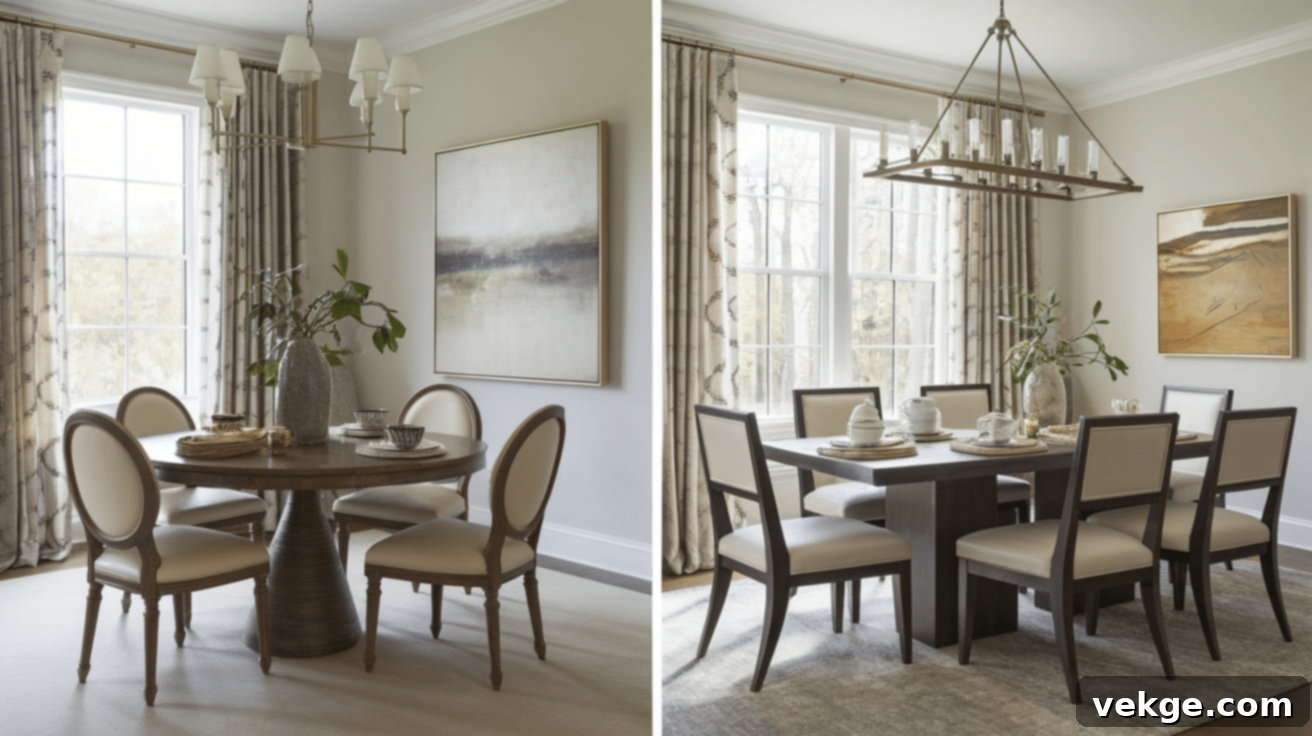
Here’s a quick comparison of the pros and cons of round and rectangular dining tables to help you make your decision at a glance:
| Feature | Round Dining Table | Rectangular Dining Table |
|---|---|---|
| Space Efficiency | Great for small spaces, fits into corners, improves flow. | Better for larger, long rooms; can anchor open spaces. |
| Seating Capacity | Seats fewer people (4-6 comfortably); some extensions. | Seats more people (6-12+), especially with extensions. |
| Versatility in Decor | Casual, flexible for diverse chair styles, modern feel. | Formal, structured look, traditional elegance, easy to style. |
| Encourages Conversation | Excellent for intimate meals, equal seating, easy interaction. | Less intimate but can seat many guests; often more formal. |
| Room Flow | Better for tight, compact spaces, easier to move around. | Works best in large, open spaces; can be bulky in small rooms. |
| Flexibility in Arrangement | Easy to move around, takes up less visual space. | Often requires more dedicated space, less fluid movement. |
| Price | Often less expensive for comparable materials/size. | Can be more expensive, especially for large or extendable models. |
| Ideal For | Small families, couples, casual meals, cozy atmospheres. | Large families, formal settings, frequent entertainers, multi-purpose use. |
Beyond the Choice: Mixing and Matching Table Shapes
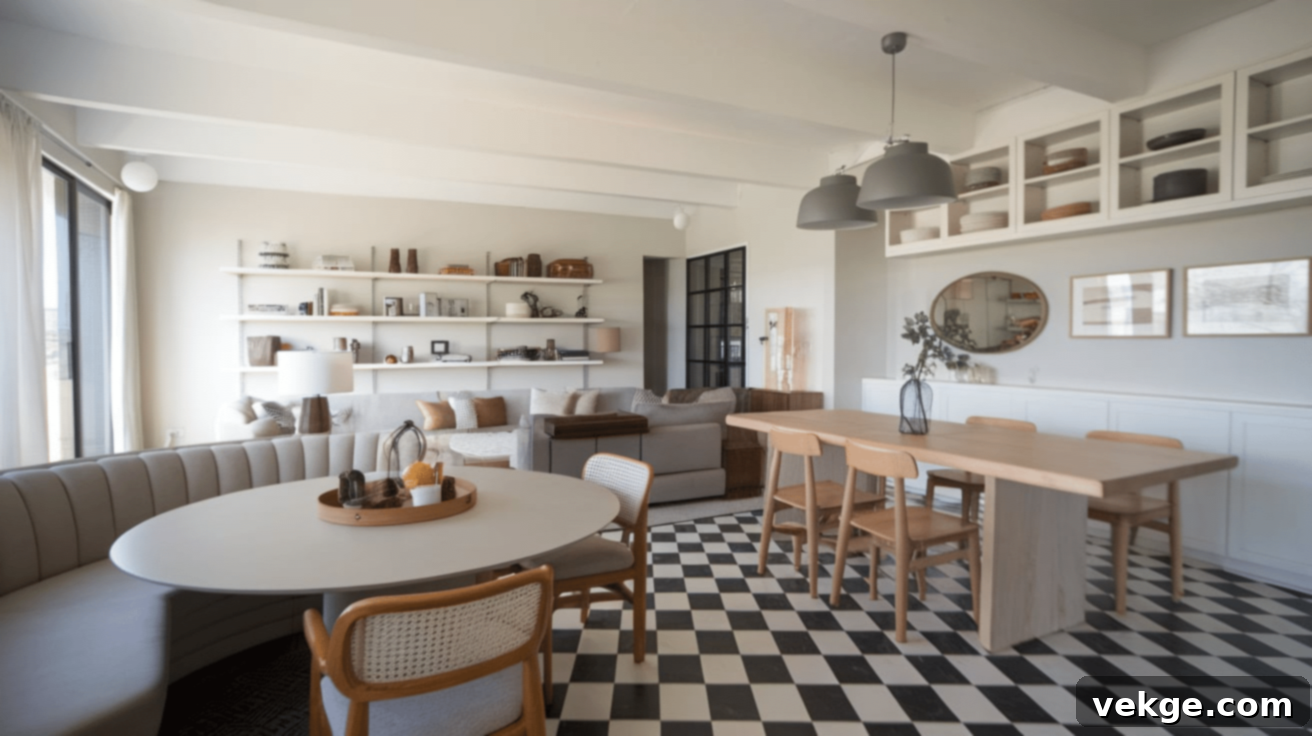
In homes with ample space or an open-concept layout, you don’t necessarily have to limit yourself to just one table shape. Mixing and matching different table styles can be a wonderfully effective way to leverage the unique benefits of both round and rectangular designs. This approach allows you to create distinct functional zones within your home, catering to various needs and occasions.
For example, you might place a charming round table in a sunlit breakfast nook or a corner of your kitchen for everyday casual meals, coffee, or quick conversations. Its intimate nature makes it perfect for smaller, informal gatherings. Simultaneously, a grander rectangular table in your main dining room can be reserved for hosting elaborate dinner parties, holiday feasts, or formal family gatherings. This setup ensures that you have the ideal table for every scenario.
This strategy not only maximizes the utility of your dining areas but also adds visual interest and dynamic flow to your home. By thoughtfully integrating both shapes, you can achieve a harmonious balance that reflects your versatile lifestyle, creating spaces that are both beautiful and incredibly functional.
Making Your Final Decision: A Checklist for Your Perfect Dining Table
To help you solidify your choice between a round and rectangular dining table, consider these key questions and factors:
Evaluate Your Dining Space
- What is the exact size and shape of your dining area?
- How much clearance do you need around the table for comfortable movement and chair pull-out?
- Is the room a dedicated dining space or part of an open-concept layout?
Assess Your Seating Requirements
- How many people will regularly use the table for daily meals?
- How often do you host guests, and what is the maximum number of people you typically need to seat?
- Do you require flexibility for expanding seating capacity?
Define Your Desired Aesthetic and Ambiance
- What style is your existing home decor (e.g., modern, traditional, rustic, minimalist)?
- Do you prefer a casual, intimate, and cozy atmosphere, or a formal, structured, and elegant setting?
- How important is the table’s role as a focal point in the room?
Consider Lifestyle and Functionality
- Will the table primarily be used for dining, or do you need it for other activities like work, homework, or crafts?
- Is ease of movement around the table a high priority (especially in high-traffic areas or with children)?
- How important is fostering conversation and an inclusive atmosphere during meals?
Set Your Budget
- What is your realistic budget for a dining table, considering materials, brand, and any extension features?
- Are you looking for a more affordable option, or are you prepared to invest more for specific features or durability?
Conclusion
Choosing between a round or rectangular dining table is a significant decision that can truly transform the feel and functionality of your home. Both shapes offer distinct advantages, and the “best” choice ultimately hinges on your unique needs, available space, and personal style preferences.
Round tables are champions of intimacy and coziness, ideal for smaller rooms, fostering engaging conversations, and creating a warm, informal atmosphere. They are perfect for small families, couples, or anyone who values connection and fluid movement. Rectangular tables, conversely, excel in versatility and grandeur, fitting beautifully into larger spaces, offering superior seating capacity, and providing a more formal and structured aesthetic for grand entertaining and multi-purpose use.
As you weigh your options, revisit your answers to the checklist above. Consider your daily routines, your entertaining habits, and the overall design vision for your home. Remember that if you have the space, mixing and matching tables can offer the best of both worlds. By thoughtfully evaluating these factors, you’ll be empowered to select a dining table that not only meets your practical needs but also perfectly complements your home’s design and enhances your lifestyle for years to come.
Frequently Asked Questions (FAQs)
What shape of dining table is best for a small room?
A round dining table is generally the best choice for smaller rooms. Its lack of sharp corners allows for better flow and movement, and its curved shape can make the room feel more open and less cramped.
Can a rectangular table work in a small space?
A rectangular table can work in a small space, especially if the room itself is narrow or long. However, it’s crucial to choose a table that is proportionally sized to avoid overwhelming the room. Opt for narrower designs or models with extendable leaves that can be collapsed when not in use to maximize space.
How many people can a round dining table seat comfortably?
A standard round dining table typically seats 4 to 6 people comfortably. For example, a 48-inch diameter table is suitable for 4, and a 60-inch diameter table can seat 6. Some round tables come with extensions, transforming them into an oval to accommodate a few more guests.
Can a rectangular dining table be extended?
Yes, most rectangular dining tables are designed with extension leaves. These leaves can be added to the center or ends of the table to increase its length and seating capacity for larger gatherings. This feature makes rectangular tables incredibly versatile for varying guest numbers.
What’s the best dining table shape for a formal setting?
A rectangular dining table is widely considered the best choice for formal settings. Its structured, linear design provides a sense of elegance, order, and traditional formality, making it ideal for sophisticated dinner parties and special occasions.
What are the advantages of a round table for conversation?
Round tables inherently encourage more intimate and inclusive conversations because everyone is seated an equal distance from each other, and there’s no “head” of the table. This allows for easier eye contact and a more natural flow of dialogue among all guests.
How do I choose the right size dining table for my room?
To choose the right size, measure your dining room and leave at least 36-42 inches (90-105 cm) of clear space between the table’s edge and any walls or other furniture. This ensures enough room to pull out chairs and move around comfortably.
Are there other dining table shapes besides round and rectangular?
Yes, while round and rectangular are most common, other shapes include oval (offering the softness of a round with more seating like a rectangle), square (great for small, square rooms), and custom shapes. Each has its own unique benefits for specific spaces and styles.
